Bedfordshire
BEDFORD
Many places in England have forgotten their spiritual heritage, but Bedford remembers its most famous son, John Bunyan (1628-1688). Sometimes it is hard to avoid him. Perhaps only Shakespeare and Stratford have a stronger association between man and place. His statue stands on St Peter's Green, and the Tourist Information Office (MK40 1SJ) provides Bunyan guides to the town and Bunyan Trails through the surrounding countryside.
With all the Bunyan memories, we must not forget Bedford's other hero, John Howard (1726-1790) who, as one author put it, was as eager to get into prisons as Bunyan was to get out! His statue stands in St Paul's Square. Howard's duties as High Sheriff of Bedfordshire led him to investigate the state of local prisons, and what he found so appalled him that he spent the remaining seventeen years of his life in an unceasing campaign of reform.
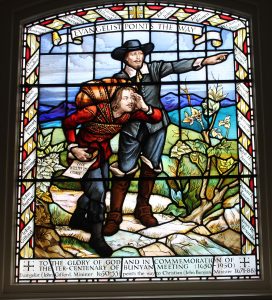
Evangelist (John Gifford)
Bunyan was born at Elstow, about three miles south of Bedford, and many memories of his early life can be seen there. As a teenager, he spent two years in the Parliamentary army, stationed mainly at Newport Pagnell, and then took up his father's trade of brazier, travelling round local villages to repair pots and pans. At the age of twenty he married his first wife, who bore him four children including a blind daughter Mary, to whom he was devoted. His wife's dowry consisted of two books, including Arthur Dent's The Plain Man's Pathway to Heaven, which together with the sermons of Christopher Hall, vicar of Elstow, set him on a spiritual journey. After a time of wrestling and confusion when he sought help from John Gifford, he was baptised in the Ouse and became a travelling preacher. Several churches around Bedford and in Hertfordshire trace their origins to Bunyan's ministry. The Restoration of Charles II in 1660 brought political stability, but little comfort to non-conformists. Arrested for preaching at a farmhouse in Lower Samsell, he was brought before the magistrate Francis Wingate at Harlington and spent most of the next twelve years in prison. Thus began Bunyan's literary career. After the death of his first wife, Bunyan remarried in 1659. His new wife Elizabeth cared for his young family and bravely pleaded for his release. The Act of Indulgence brought freedom in 1672 and for the remainder of his life Bunyan wrote, preached and ministered to a congregation in a barn in Mill Street, where the present Bunyan Meeting now stands. During a further short spell of imprisonment in 1675-76, he completed the first part of Pilgrim's Progress. In 1688, returning to London from Reading, he was drenched in a rainstorm and succumbed to a fever. He died at the house of a friend in Holborn and is buried in Bunhill Fields, on the City Road, London.

John Gifford's rectory
For a Bunyan tour of Bedford, we can start south of the river. In Bunyan's time, the rector of St John's Church was John Gifford. The small church in St John's Street (MK42 0DH) has a stone tower with one bell and was extensively restored in the nineteenth century. Next to it is Gifford's rectory, an ancient building, now used as the local headquarters of St John's Ambulance. It has a room devoted to the Bunyan connection, which can be visited by appointment. A plaque on the wall tells us simply that, Here John Bunyan sought spiritual help from John Gifford. In Pilgrim's Progress, Gifford can be readily identified as Evangelist, who pointed Christian in the right direction with the exhortation Do you see yonder shining light?
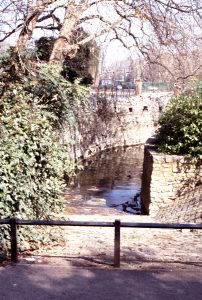
Site of Bunyan's baptism
A short walk from St John's, down Cardington Street and up a cul-de-sac called Chethams, brings us to the site of Bunyan's baptism, a shady backwater on the south side of the river Ouse, marked by a plaque. From here, we can walk to the bridge, with plenty more Bunyan memories on the north side. The bridge itself was built in 1813, replacing an earlier one on which stood a small prison, where Bunyan probably served his second brief period of captivity.

Swan Hotel
The Swan Hotel was built in 1794, replacing the earlier Swan Inn, where in August 1661 Elizabeth Bunyan pleaded before three judges including the Lord Chief Justice Matthew Hale for her husband to be called from prison to state his own case. Hale was sympathetic but was opposed by the other two, Chester and Twisden, who may thus have found themselves jointly immortalized as Lord Hategood of Vanity Fair. A picture of Elizabeth pleading with the judges can be seen in the Bunyan Museum. The building of the new Swan Hotel coincided with the demolition of Houghton House, near Ampthill, the model for Bunyan's House Beautiful. Its magnificent staircase was acquired for the hotel and can be seen in the entrance hall.

John Howard statue
In St Paul's Square opposite the Swan Hotel is the statue of John Howard by Sir Alfred Gilbert. It was erected in 1890 to commemorate the centenary of his death. He stands in frock coat and tricorn hat, looking thoughtful as he contemplates issues of crime and punishment. St Paul's Church seems to have few connections with Bunyan or Howard, but remembers a visit by yet another John, this time John Wesley. Using the ancient stone pulpit, he preached a famous sermon at the Assizes on March 10th 1758. His subject was The Great Assize, with the text We shall all stand before the judgment seat of Christ. The pulpit was removed from the church in 1831, but restored to its original place in 1929 and is now called the Wesley Pulpit.
From St Paul's, the traffic-free Harpur Street leads to Bedford Central Library (MK40 1PG). A modern sculpture of scenes from Pilgrim's Progress covers one wall of the foyer. The library has a large collection of works relating to Bunyan, including the private library of Bunyan's biographer, Dr Frank Mott Harrison. The Bedford County Gaol used to stand on the corner of Silver Street, now a pedestrian precinct, and the High Street. A stone slab set into the pavement commemorates Bunyan's imprisonment here from 1660 to 1672. The prison was demolished in 1801, but a cell door and items relating to his captivity are preserved in the Bunyan Museum.
The Bunyan Statue on St Peter's Green (MK40 2TH) at the junction of the High Street and St Peter's Street was sculpted by Sir Edgar Boehm in 1874. Set into the pedestal are panels showing three scenes from Pilgrim's Progress - Christian fighting with Apollyon, Evangelist directing him to the wicket gate and the Three Shining Ones pointing out the Celestial City.
Our Bunyan trail continues in a roughly clockwise direction along St Peter's Street and turning right into St Cuthbert's Street. A plaque on Number 17 marks the site of the cottage where Bunyan and his family lived from 1655 to the end of his life. When it was demolished in 1838, a Deed of Gift drawn up in 1685 was found behind a brick near the chimney. In it, Bunyan left his entire estate, such as it was, to his wife Elizabeth. The document is on display in the Bunyan Museum.
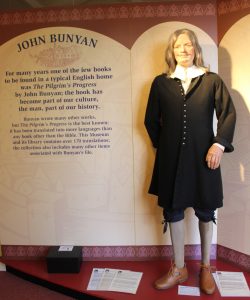
Bunyan Museum
On the corner of Mill Street and St Cuthbert's Street is the Bunyan Meeting Free Church (MK40 3EU) with the adjoining Bunyan Museum. In 1672, Bunyan bought a barn and orchard in Mill Street to accommodate his growing congregation. It was replaced by a Meeting House in 1707, and the present church was built in 1849. The massive bronze doors are the work of sculptor Frederick Thrupp and were presented by the Duke of Bedford, who also paid for the classical porch as a suitable setting. Modelled on the Baptistry doors in Florence, they have ten relief panels showing scenes from Pilgrim's Progress. Inside, the church is light and airy and welcomes visitors on most weekdays. The ground floor has modern brightly coloured stained glass windows. Most panels show the hazards and triumphs of Christian's journey to the Celestial City, but one shows Bunyan in his cell in Bedford Gaol, gazing longingly out at the sunshine through the bars. It was a postcard of this window, sent by a Bedford family, that reached Terry Waite during his captivity in Beirut.

Bunyan's flute & jug
In 1998 the excellent John Bunyan Museum was opened in a new building alongside the church. It is compact but well presented and employing modern audio-visual techniques. Items displayed include the door to a cell in Bedford Gaol, a jug in which little blind Mary brought soup to her father, an iron fiddle and a flute made from a chair leg, both possibly made by Bunyan himself during the long, lonely years. There is a mock up of the cell in Bedford Gaol and a street scene showing the young Bunyan using his brazier and last to repair local ironmongery. The last is Bunyan's original, engraved with his name and the date 1647. It was found in a scrapyard early in the 20th century. The pulpit from the Zoar Street Chapel in Southwark where Bunyan preached in later life is shown here, as is the original door from the west end of Elstow Church, probably the model for Pilgrim's Wicket Gate.
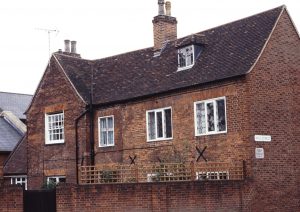
John Howard's house, Bedford
The Bunyan Meeting and Museum form a kind of L-shape and within the L is a seventeenth century house, owned and used by the prison reformer John Howard between 1764 and 1789. For much of this time he was travelling abroad on philanthropic missions, but would stay here during brief intervals at home. Howard attended a Congregational Church, but following a dispute over infant baptism he broke away with others to form a separate church. In 1774, a building was erected in Mill Street largely at Howard's own expense. Altered and extended in 1849, it stands a short distance from the Bunyan Meeting. It has an impressive white facade and the name Howard Chapel set into the stonework across the front. It is now in secular use.
In 1773, John Howard was appointed High Sherifff of Bedford, an honorary post lasting only a year, but for him it led to a lifetime commitment. One of his duties was to look into the state of local prisons. The first one he visited was on the bridge across the Ouse, the probable scene of Bunyan's incarceration a century before. Howard was so shocked by the conditions, that he spent the remaining years of his life on an unceasing crusade to improve the lot of captives all over Europe.
ELSTOW
Elstow used to carry the main A6 into Bedford, but today it is now an oasis of calm in a constantly changing landscape of warehouses, roundabouts and industrial estates. We come here to follow the pilgrimage of John Bunyan, whose long incarceration in Bedford Gaol gave us the work which, in vivid allegory, describes the trials, temptations and triumphs of every Christian pilgrim. Despite the passage of over 300 years there is still plenty to see. The Abbey Church, the Green and the Moot Hall are rich in memories of Bunyan's early life and from scenes here we may trace many images on Pilgrim's journey.
Bunyan's Birthplace
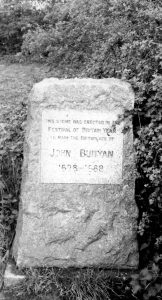
Site of Bunyan's birthplace
Demolished in the 19th century, the cottage where Bunyan was born stood beside a brook that runs between Elstow and Harrowden. The site is marked by a rough granite memorial erected in 1951, which can be reached from Harrowden. Turning down Old Harrowden Road from the A600, the road peters out altogether at Bunyan Farm. A farm track turns sharp right and after about 100 yards a sign on the left indicates the path to follow. A five-minute walk beside the brook brings you to the spot in the corner of the next field (MK42 9GL).
High Street

Elstow High Street
After a period of service in the Parliamentary army, Bunyan returned to Elstow and set up home with his first wife, living in a cottage in the High Street from 1649 to 1653. This was demolished for road widening in 1968. The site, in the closed off section north of the junction with West End, is marked by a plaque at the entrance to the St Helena restaurant. Opposite is the Bunyan Memorial Hall, with stained glass windows showing scenes from Pilgrim's Progress.
In the lower part of the High Street, the cottages on the east side have been restored to their former half-timbered style as Bunyan would have known them, with plasterwork painted gleaming white. Elstow's main street once had many inns, serving the coaches that passed through. The number is now reduced to two, one of which - the Swan - would certainly have been known to Bunyan.
Moot Hall
This handsome Tudor building with red brickwork and exposed beams was a market place in Bunyan's time. It displays the pulpit used by Christopher Hall, vicar of Elstow from 1639 to 1664, whose sermons began to arouse Bunyan's conscience. One end of the ground floor is screened off and furnished as a typical 17th century parlour. Elsewhere there are displays of local crafts, while upstairs is an exhibition of furniture and domestic items.
Village Green
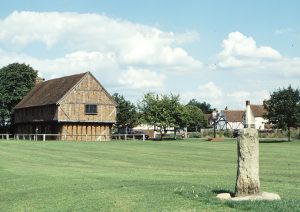
Moot Hall and village green
The village sign proclaims Elstow as Bunyan's birthplace. On one side Christian is staggering under his heavy burden, while on the other Christian and Faithful walk through Vanity Fair, assaulted by temptations an all sides. The background shows the Moot Hall, standing in reality just to the left. Fairs held on Elstow green for generations provided Bunyan with the model for Vanity Fair.
Beyond the Moot Hall is the stump of a market cross. It was near this spot one Sunday that Bunyan, playing a game of "tipcat", was suddenly arrested by the question Wilt thou leave thy sins and go to heaven, or have thy sins and go to hell? He had heard a sermon that morning condemning Sunday sports, but a good meal had assuaged any pangs of conscience. It now seemed that God himself was on his case and it marked the beginning of a long spiritual journey.
Abbey Church of St Mary and St Helena
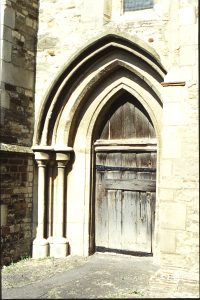
Wicket Gate, Elstow
The Abbey (MK42 9XT) was originally a nunnery founded by a niece of William the Conqueror in 1078. After the Dissolution of the Monasteries, it was transformed, much reduced in size, into a parish church. There is a brass to a former abbess, one of only two such brasses in England. We enter by the central door at the west end but just to the left is a smaller door with heavy iron hinges, now blocked off. To Bunyan's vivid imagination the two doors were a visible parable of the broad and narrow ways. The little door became the Wicket Gate of Pilgrim's Progress. The bell tower is detached from the body of the church and Bunyan would ring the bells here on Sundays - something he later considered a grievous sin. In his allegory, this became Beelzebub's Tower, a stronghold of satan, firing darts and arrows on pilgrims as they hurried through the gate.
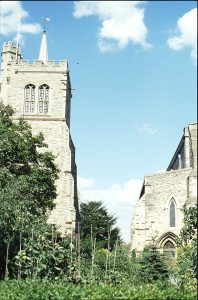
Beelzebub's Tower
In the north aisle is the font where Bunyan was baptized in 1628, his blind daughter Mary in 1650 and another daughter Elizabeth in 1654. The east windows of the north and south aisles have scenes from the Holy War and Pilgrim's Progress. The window to the left, we are told, is to remind all Christian people of the Holy War they should be engaged in on the side of Emmanuel. A grim-looking castle and knights in shining armour graphically illustrate the point.
The chapel on the right hand side has the altar rails and a table from which Bunyan would have received communion. The window above shows six scenes from Pilgrim's Progress, helpfully explained by an adjoining display. They include Christian leaving the City of Destruction, losing his burden, knocking at the Wicket Gate and fighting with Apollyon.
On the south side of the church are the ivy-covered ruins of a house built for Sir Thomas Hillersden in 1616. They are fenced off and slowly crumbling away, but an imposing stone entrance which may have been the work of Inigo Jones can still be seen, and this may have provided the model for the House of the Interpreter, where Christian met an honest man who explained mysteries to him.
HARLINGTON

Harlington Manor
In this village, a dozen miles south of Bedford, began a train of events that led to John Bunyan's imprisonment. On the night of November 12th 1660, ignoring warnings from friends, Bunyan began to preach in a farm at a hamlet then called Lower Samsell. After a short while, two burly constables appeared with a warrant for his arrest. Today, Samshill Farm is passed by walkers following the John Bunyan Trail. While the buildings will have changed, the general ambience of the place and surrounding countryside is probably quite similar. It lies about a mile east of Westoning, just north of Harlington.
Bunyan was taken before the local magistrate Francis Wingate at Harlington Manor (LU5 6PB), Wingate's large gabled house standing on the corner of Station Road and Westoning Road. It is privately owned and only one side can be seen from the road. The more impressive aspect is obscured by trees and a high wall.
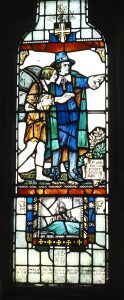
Bunyan window, Harlington Church
The scene that followed was recorded by Bunyan in his autobiography Grace Abounding. In the presence of Dr Lindall the vicar of Harlington and Wingate's kinsman William Foster, together with several of Wingate's curious children, Bunyan was questioned as to his purpose. He replied that he had come to instruct the people and to persuade them to close in with Christ, lest they should miserably perish. Wingate lost his temper declaring that his aim was to break the neck of their meetings and committed Bunyan to Bedford Gaol. Foster attained a kind of immortality by becoming the model for Mr By-Ends in Pilgrim's Progress. Thus began Bunyan's imprisonment, which despite the determined efforts of his wife and friends continued for nearly twelve years.
Perhaps embarrassed by the role of their former vicar in Bunyan's fate, St Mary's Church today encourages visitors to explore Bunyan connections in the area. A stained glass window on the south side of the chancel was installed in 1929 In memory of John Bunyan, arrested for field preaching in this neighbourhood. It depicts Christian being pointed in the right direction by Evangelist, with the question Do you see yonder shining light?
Halfway between Harlington and Sharpenoe is a new housing development called Aldberry Green. From here a public footpath leads to Westoning, part of the John Bunyan Trail. Some distance from the path but clearly visible to the north is the Bunyan Oak, a regular preaching spot and not far from the vanished farmhouse at Lower Samsell. The oak is clearly dead but a new sapling has been planted nearby to replace it. The branches of the old tree have been cut short and seem like the fingers of an ancient ghostly hand reaching up from the earth.
Scenes from Pilgrim's Progress
Writers today can draw on a host of sources to inform their plots and settings. Bunyan was a man of little education and his reading was limited to the Bible and a few chosen Puritan volumes. How did he produce such vivid and original work? The question is best left to scholars, but in simple terms the answer is - a fertile imagination and the landscape of his own native county.
At Elstow, we have already seen that features of the church and village suggested many of the images used in the classic work. Elsewhere in the Bedfordshire, other scenes from Pilgrims Progress can be identified with varying degrees of certainty.
The Cross
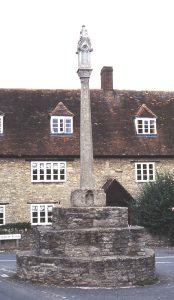
Stevington Cross
The ancient market cross at Stevington (MK43 7QP), a few miles west of Bedford, isn't really a cross at all - more a column topped by a gothic pinnacle with small cheeky-faced gargoyles. Bunyan came here in Commonwealth times and it is widely accepted that he took Stevington's column as the model for the cross where Christian lost his burden in the early pages of Pilgrim's Progress.
More tangible evidence of Bunyan's presence is the Baptist Chapel about a mile west of the village, which traces its origins to his preaching here in 1655. A plaque tells us that the present stone building dates from 1720 with renovations in the 19th century.
The House Beautiful
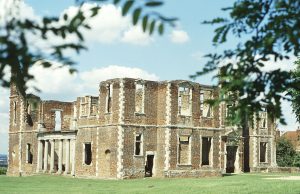
Houghton House
On the edge of the scarp a mile north of Ampthill stands the House Beautiful of Pilgrim's Progress, where Christian knocked on the door and met four gracious damsels. It is Houghton House (MK45 2 EZ), built in 1615 for Mary, Countess of Pembroke, sister of Sir Philip Sidney. It was altered a few years later probably by Inigo Jones and dismantled in 1794. One of its finest features, the magnificent staircase, can be seen in the Swan Hotel by Bedford bridge.
To reach the site, we bear right down a farm road just before the steep hill (perhaps the Hill Difficulty) on the road to Bedford. Today, the house is a magnificent roofless ruin, but the setting is sublime and the view, despite the chimneys of a large brickworks, superb.
The Delectable Mountains
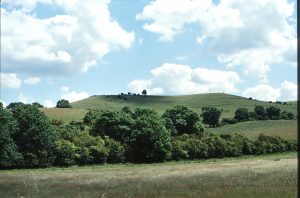
Barton Hills
Running east to west between Harlington and Hitchin are the Barton Hills, which Bunyan would have known well from his preaching journeys. Rich in wild flowers in springtime, these are the Delectable Mountains and a sight that he must have yearned for during his long years in Bedford gaol.
The Valley of the Shadow of Death
The village of Millbrook lies in a cleft in the hills just west of Ampthill. Today the road is overhung with trees, but does not appear too threatening. In Bunyan's day the track may have run through the wooded gully below the road, and in the days before street lights and road signs it was probably a fearful place.
EDWORTH
This village just off the A1 was the setting for a romantic tale involving John Bunyan. A young woman called Agnes Beaumont lived at a farmhouse, now called Beaumonts. It lies to the right a short way down a private road leading to Edworth Manor Farms and the church. The house has been much extended in recent years and is privately owned, although a public footpath passes the front door.

Beaumonts Farm
Recently released from goal, Bunyan was an itinerant preacher and Agnes and her brother became devoted followers. She would attend his meetings despite the disapproval of her father, John Beaumont. On one occasion, Bunyan himself gave her a lift on horseback to a meeting in Gamlingay. On her return, her father bolted the door against her and she spent the night in a barn, later taking refuge with her brother. A few days later her father was seized with a fatal illness and died. There were rumours that John Beaumont had been poisoned and suspicion fell upon Agnes. An enquiry was called and the coroner, clearly impressed by her beauty and character, declared her completely innocent. In later life Agnes became Mrs Story, and is buried at Hitchin Baptist Church in Hertfordshire.
CARDINGTON
At the corner of Church Lane (MK44 3SU), adjacent to the churchyard, is a handsome house dated 1642, which was the home of John Howard (1726-1790), the prison reformer. It is much as it was in Howard's day except that an extra room has been added each side. In the garden, but not visible, is a strange lead statue of a gamekeeper on skates, which may have been a gift to Howard after his first visit to Russia.
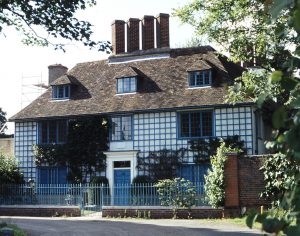
John Howard's house
Born at Hackney in London, Howard inherited a considerable fortune and for a time lived the life of a benevolent country gentleman. Appointed High Sheriff of Bedford in 1773, one of his duties was to look into the state of prisons in the county. Appalled by what he found, Howard immediately began a series of journeys to study prison conditions, which continued until his death in 1790. His work began in Britain but extended to almost every country in Europe. He assembled a great volume of information on overcrowding, disease, torture, malnutrition and general degradation. His book The State of the Prisons was first published in 1777 and was extended with successive editions as he acquired further information. He had numerous adventures including an attack by Turkish pirates in the Mediterranean, where Howard himself took over the only cannon and drove them off. In January 1790, he finally succumbed to smallpox at Cherson, in the Ukraine, where he is buried.
In St Mary's Church, Howard is remembered by a simple marble tablet inscribed Christ is my hope on the north wall in a curtained area behind the organ. There is a much more elaborate memorial to Samuel Whitbread, founder of the brewery, who was a kinsman of Howard and supported his work in parliament. It is by John Bacon, who carved the statue of Howard in St Paul's cathedral. The Whitbread family built or restored many of the cottages in the village. These are indicated by roundels with the letters S W and the date.
MOGGERHANGER

Moggerhanger Park
On the edge of this strangely named village, just east of Bedford, is Moggerhanger Park (MK44 3RW), a country house designed by Sir John Soane and surrounded by extensive grounds. From 1733 to 1857 this was the home of the Thornton family, relatives and colleagues of William Wilberforce. It later served as an isolation hospital, and has now been restored as a Christian conference centre and venue for business and family occasions. The grounds - with a delightful woodland walk rich in snowdrops and bluebells - are open all year round, while tours of the house are arranged during summer months.
The Thorntons were leading members of the Clapham Sect and gave generous support to Wilberforce in his many philanthropic projects, particularly his battle against the slave trade. Housed in outbuildings close to the tea rooms is a gift shop and exhibition giving the history of the estate.
EVERTON

John Berridge's tomb
The eighteenth century revival threw up some unusual characters, none more so than the eccentric John Berridge (1716-1793), vicar of St Mary's Church (SG19 3JJ), who arrived in 1755 and remained until his death nearly forty years later.
Berridge was a friend of George Whitefield and the Wesleys. Shortly after his arrival here he underwent a sound conversion or, as his tombstone records, fled to Jesus alone for refuge, 1756. Within a few months, his congregation experienced a dramatic revival. There were outbreaks of hysteria during his sermons, although Berridge claimed that he merely prattled about Jesus and strongly denied any attempt to whip up emotion.
The church, built of irregular stone blocks, with Disney-like pinnacles on the corners of the tower and strange gargoyles near the door, appears as eccentric as the vicar himself. Berridge's tomb, just to the north of the church, carries his autobiographical epitaph, recently restored. He describes himself as ...an itinerant servant of Jesus Christ, who loved his Master and his work and after running on his errands many years was called to wait on him above... and then challenges the visitor Reader, art thou born again? No salvation without new birth!
TURVEY
All Saints Church (MK43 8EP) in this tidy, prosperous village contains impressive Tudor monuments to the Mordaunt family, but we come here for another reason. Legh Richmond (1772-1827) was vicar from 1805 until his death and is buried here. Richmond is best known for a series of tracts called Annals of the Poor, based on his experiences as a curate on the Isle of Wight. The most famous of these, The Dairyman's Daughter, was translated into several languages and 2,000,000 copies were printed in his lifetime.
He is commemorated by a marble plaque on the north wall, with a flowery-phrased inscription typical of the period. Part of it reads To amiableness of disposition and simplicity of character, he united fervency of zeal and holiness of life.... Other plaques remember several of his eight children.


